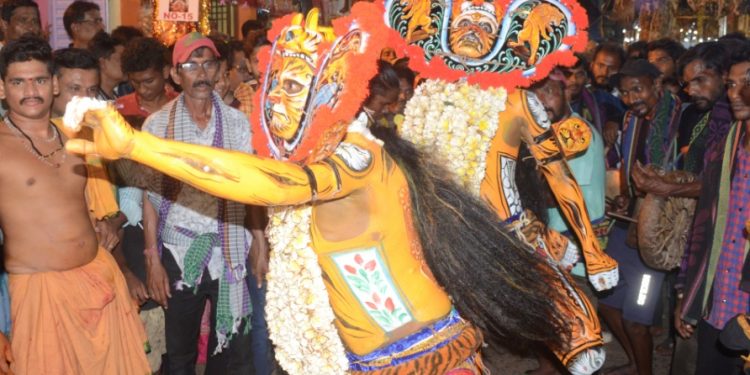Berhampur: Tiger dance or ‘Bagha Nacha’ is one among the many attractions that draw thousands of devotees and visitors to Maa Budhi Thakurani Yatra, a festival dedicated to the presiding deity of Berhampur. ‘Bagha Nacha’ is also prevalent in neighbouring Andhra Pradesh and West Bengal. However, the ‘Bagha Nacha’ of Berhampur, a traditional dance form, attracts one and all with its unique decorations, dance style and musical instruments. Devotees observing penance before the deity also dress up in tiger attires and dance all the way while participating in the procession. They perform the dance to appease the Goddess and get her blessings.
Sources said that the Goddess is one of the most revered deities in Berhampur. The city has a long history and rich cultural heritage and the worship of Maa Budhi Thakurani is an integral part of that culture. The deity was originally worshipped by the Dera people, members of weaver community from Rajmuhendry in Andhra Pradesh. In its early days, the community people migrated to Berhampur and established the Thakurani temple, which is located near Bada Bazaar in Silk City.
With the passage of time, worship of the Goddess has spread to other communities and now, she is regarded as the presiding deity of all residents in the city. Maa Budhi Thakurani Yatra is a biennial festival that continues for around a month every two years. The temple is unique in the sense that it shows a close association between the lower caste people and mainstream Hinduism. The priests in the temple are from the barber caste while the devotees come from various castes.
During the festival, the Goddess leaves the temple and stays at a temporary shrine at Desibehera Street like a daughter returning to her parental house after marriage. One has to become an expert in the dance style to participate in ‘Bagha Nacha’. It is a dance form that requires a lot of expenses. The dance necessitates four ‘Changus’, a kind of traditional musical instrument. People playing ‘Changu’ are required to warm up the instrument in fire every hour for which a vehicle laden with haystacks follows the performers during the procession.
Earlier petromax lights were being used to light up the procession but now big generators are in use mostly. The person who performs the dance dresses in a tiger costume paints his body, and head in varnish with stripes resembling a tiger, and puts on garlands of flowers. They have to spend a good amount of money on body painting and costumes and get their body hair shaved off before painting. The dance starts after the mask of the Goddess is worshipped at her transit shrine. They dance to the beats of musical instruments like ‘Changu’ and other instruments and visit the transit shrine to pay obeisance to the deity.
As many as 20 people roam the streets the whole night and visit the houses of their kin and relatives performing the dance. Earlier, the dance was performed the whole night but with restrictions in place, it has been banned from 11 pm till 5 am.






































